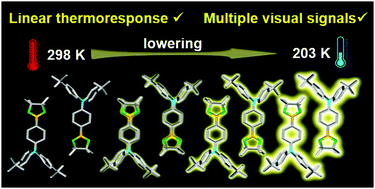Full-type photoluminescence from a single organic molecule for multi-signal temperature sensing†
Abstract
Photoluminescent materials are one of the most important materials widely used in various fields. They emit normally a single type of photoluminescence at room temperature, either fluorescence (FL), delayed fluorescence (DF), or phosphorescence (RTP). Here, uncommon full-type photoluminescence including concomitant FL, DF, and room-temperature phosphorescence (RTP) from a single organic molecule is reported. The material shows unique aggregation-induced phosphorescence (AIP) and remarkable thermoresponsive persistent phosphorescence (TPP). Interestingly, TPP, together with thermoresponsive FL and DF of the chromophore, gives rise to multiple visual signals including luminescence colour, colour evolution, brightness, and fading rates upon temperature variation, affording a new class of thermoresponsive materials. More importantly, the incorporation of the chromophore into polymers further amplifies its luminescence thermoresponse. In particular, the phosphorescence lifetime of the doped films increases linearly by 8-fold with lowering temperature, which is highly desirable for quantitative temperature sensing but rarely reported. Furthermore, a facile method based on phosphorescence lifetime and image analysis (PLIA) of the doped films is used for quick, visual, and quantitative temperature sensing.

- This article is part of the themed collection: 2021 Materials Chemistry Frontiers HOT articles


 Please wait while we load your content...
Please wait while we load your content...